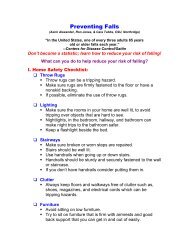Why Shoes Make “Normal” Gait Impossible - RonJones.Org
Why Shoes Make “Normal” Gait Impossible - RonJones.Org
Why Shoes Make “Normal” Gait Impossible - RonJones.Org
You also want an ePaper? Increase the reach of your titles
YUMPU automatically turns print PDFs into web optimized ePapers that Google loves.
<strong>“Normal”</strong> <strong>Gait</strong>...<br />
shoe. If the toe end, tip to ball, lifts<br />
easily, the shoe is flexible. The degree<br />
to which it resists toe lift is the<br />
degree to which it is inflexible. (Fig.<br />
22)<br />
The more inflexible the shoe,<br />
the more flat-footed the gait manner.<br />
With inflexible or semi-flexible<br />
shoes (which include most) the step<br />
push-off is almost wholly from the<br />
ball, thus fulfilling only half to<br />
three-fourths of the natural step sequence.<br />
Shoe Weight<br />
Most shoes weigh too much. The<br />
average pair of dress shoes weighs<br />
about 34 ounces; a pair of wingtip<br />
brogues about 44 ounces; some<br />
work and outdoor boots up to 60<br />
ounces or more. Women’s dress and<br />
casual shoes average 16-24 ounces a<br />
pair; women’s boots about 32<br />
ounces.<br />
A lightweight pair of 16-ounce<br />
shoes amounts to a cumulative four<br />
tons of foot-lift load daily (16 ounces<br />
times 6,000 foot-lift steps). If the<br />
shoes weigh 32 ounces, daily footlift<br />
load is eight tons; 44 ounces<br />
adds up to 11 tons a day. Every<br />
added four ounces of shoe weight<br />
adds another one ton to foot-lift<br />
load.<br />
These foot lift loads impose an<br />
energy drain not only on the foot<br />
but the whole body. It is a common<br />
though little recognized<br />
source of foot and body fatigue—<br />
which is why, after a long day on<br />
one’s feet, one arrives home feeling<br />
“dog-tired” and kicks off one’s<br />
shoes.<br />
You can walk several miles carrying<br />
a four-pound<br />
weight on each<br />
shoulder. But you<br />
can barely manage<br />
100 yards<br />
with the same<br />
weight attached<br />
to each foot. The<br />
reason is simple<br />
physics: the farther<br />
the load from<br />
the center of gravity,<br />
the heavier<br />
the energy and<br />
“lift” strain.<br />
No footwear,<br />
with certain exceptions, should<br />
weigh more than 12 ounces a pair<br />
for women, 16-18 ounces for men.<br />
Excessive shoe weight forces an<br />
alteration of natural gait form. The<br />
drag effect and energy drain of the<br />
shoes creates alterations in the natural<br />
step sequence—a smooth, easy<br />
movement heel to lateral border to<br />
ball to toes is disrupted. The common<br />
descriptive expression “dragging<br />
one’s feet” aptly applies here.<br />
Fig. 21: Two<br />
views of deceptive<br />
shoe<br />
flexion. The<br />
flexion is behind,<br />
not at<br />
the ball.<br />
Snug or narrow fit<br />
has a negative effect on<br />
gait because the natural<br />
expansion of the<br />
foot with each weightbearing<br />
step is<br />
prevented.<br />
Fig. 22: Top, wrong<br />
shoe flexion, with<br />
bend behind ball;<br />
bottom, correct<br />
flexion at ball.<br />
Shoe Fit<br />
There is substantial and incontestable<br />
evidence that no commercial<br />
footwear fits properly, regardless<br />
of type, brand, style, or price. This is<br />
because of a combination of inherent<br />
faults in the lasts, shoe design<br />
and construction. Even the shoe sizing<br />
system itself is riddled with<br />
faults (we are, incredibly,<br />
still<br />
using the “sys-<br />
tem” introduced<br />
630 years ago and<br />
“updated” 117<br />
years ago).<br />
One example<br />
is width fit. A<br />
recent study was<br />
conducted by Dr.<br />
Francesca M.<br />
Thompson, chief<br />
of the Adult Orthopedic<br />
Clinics<br />
at St. Luke’s Hospital,<br />
New York, involving several<br />
hundred women. The average measurement<br />
across the ball of the foot<br />
was 3.66 inches, but the shoe measurement<br />
at the same site measured<br />
less than three inches. Thus, almost<br />
all were wearing shoes 20 percent<br />
too narrow at the ball (Fig. 23)<br />
Too-narrow or “snug” width fit<br />
occurs with about 90 percent of<br />
men’s and women’s shoes alike. In<br />
Continued on page 59<br />
58 PODIATRY MANAGEMENT • MARCH 1999













